Improve the inefficient learning environment by practicing VMware 2V0-51.23 actual exam questions in advance! Learn how to reduce time and complete your goals efficiently.
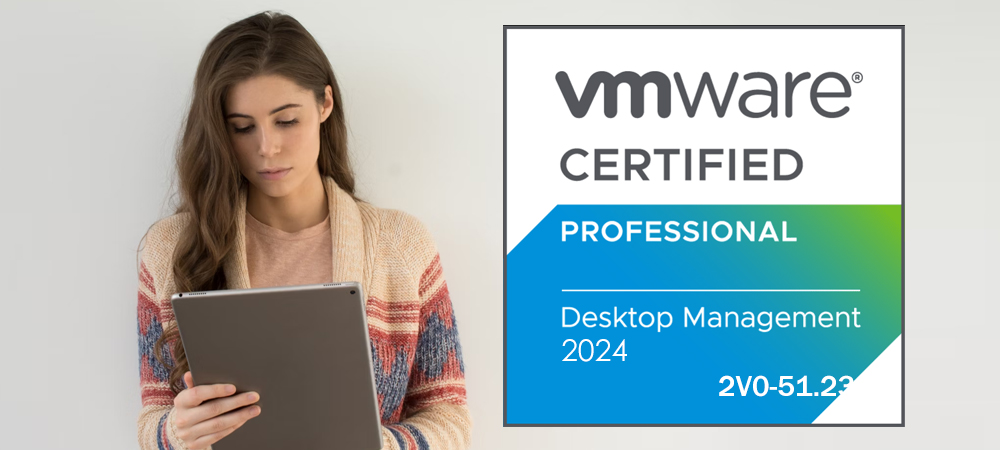
VMware 2V0-51.23 actual exam questions include 87 questions: https://www.leads4pass.com/2v0-51-23.html (with two practice tools, PDF and VCE).
Candidates must carefully complete the VMware 2V0-51.23 practical exam question practice plan to ensure 100% success.
Provided by Leads4Pass to share a selection of VMware 2V0-51.23 practical exam questions and answers online for free:
The latest VMware 2V0-51.23 actual questions online practice
| IT Supplier | Number of exam questions | Related certifications |
| Leads4Pass | 87 Q&A | End-User Computing |
Question 1:
Refer to the exhibit.
Drag and drop the appropriate firewall ports supporting the Blast Extreme protocol into the correct locations in the diagram on the right.
Two options will not be used.
Select and Place:
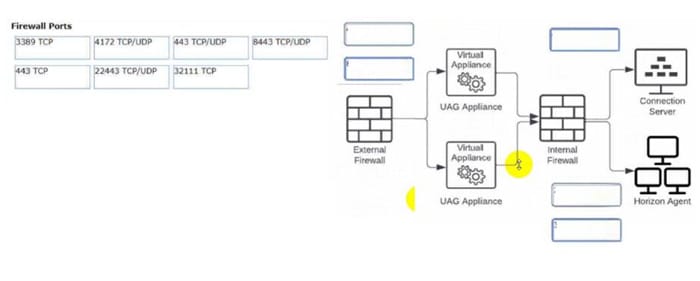
Correct Answer:
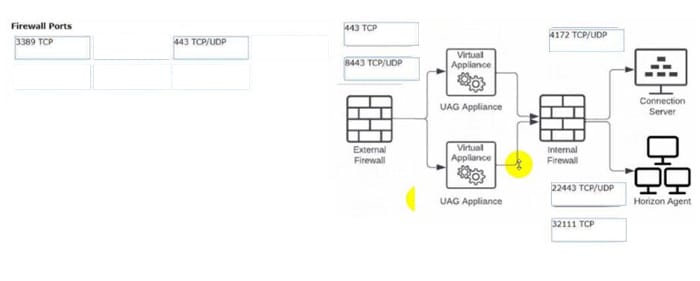
C:\Users\Waqas Shahid\Desktop\Mudassir\Untitled.jpg
Question 2:
Which three VMware Horizon-based resources does Unified Access Gateway (UAG) provide access to? (Choose three.)
A. virtual desktops
B. RDSH-based applications
C. physical Windows machines
D. IOT devices
E. thin clients
Correct Answer: ABC
Explanation:
Unified Access Gateway (UAG) is a secure gateway appliance that provides access to VMware Horizon-based resources such as virtual desktops, RDSH-based applications, and physical Windows machines. UAG supports multiple authentication methods and protocols, such as SAML, OAuth, and RADIUS, to provide secure access to end users from any device and location. UAG also provides edge services such as load balancing, high availability, and firewall rules to optimize the performance and availability of Horizon-based resources12.
References:= 1: VMware Horizon Architecture Planning: Unified Access Gateway 2: VMware Unified Access Gateway Administration Guide: Introduction to Unified Access Gateway
Question 3:
An administrator wants to deploy an RDS farm that can be patched in a rolling process with zero downtime. Which of the following statements is true in this scenario?
A. This cannot be done as updating a Farm always incurs downtime.
B. Create an instant-clone RDS desktop farm.
C. Create a manual RDS desktop farm.
D. Nothing needs to be done. All RDS farms can be patched in a rolling process with zero downtime.
Correct Answer: B
Explanation:
Instant clones are a type of virtual machine that are created by cloning a running parent VM in memory, without requiring a full disk copy.
This allows for faster provisioning and updating of RDS hosts in a farm. Instant clones can be patched in a rolling process with zero downtime by using the push-image operation, which replaces the existing instant clones with new ones that have the latest patches applied.
The push-image operation can be performed on a per-farm basis or multiple farms at once. The push-image operation preserves the user sessions and data on the existing instant clones until they are logged off or disconnected, and then deletes them.
The new instant clones inherit the same settings and assignments as the old ones. Therefore, to deploy an RDS farm that can be patched in a rolling process with zero downtime, the administrator should create an instant-clone RDS desktop farm.
References: Instant Clones for RDSH in VMware Horizon 7.1 and [VMware Horizon 8. x Professional Course]
Question 4:
Which two scenarios are appropriate for a cloud implementation of a VDI solution over an on-premises solution? (Choose two.)
A. The organization already has the infrastructure to support a VDI.
B. The organization needs to set up high availability and disaster recovery.
C. The organization needs to quickly scale up in disparate geographical locations.
D. The organization has a limited CapEx budget.
E. The organization controls highly confidential data.
Correct Answer: CD
Explanation:
A cloud implementation of a VDI solution over an on-premises solution is appropriate for the following scenarios:
The organization needs to quickly scale up in disparate geographical locations. A cloud VDI solution can provide faster provisioning, deployment, and management of virtual desktops and applications across multiple regions and data centers.
A cloud VDI solution can also offer better performance, availability, and user experience for remote and mobile workers who need to access their desktops and applications from anywhere and any device12.
The organization has a limited CapEx budget. A cloud VDI solution can reduce the upfront capital expenditure (CapEx) required to purchase, install, and maintain the hardware and software infrastructure for a VDI solution.
A cloud VDI solution can also lower operational expenditure (OpEx) by shifting the responsibility of managing, updating, and securing the VDI infrastructure to the cloud provider. A cloud VDI solution can offer flexible and predictable pricing models based on usage, subscription, or consumption13.
The other scenarios are not appropriate for a cloud implementation of a VDI solution over an on-premises solution because:
The organization already has the infrastructure to support a VDI. If the organization has already invested in the hardware and software resources to support a VDI solution, it may not be cost-effective or feasible to migrate to a cloud VDI solution.
The organization may also have existing policies, processes, and workflows that are tailored to the on-premises VDI solution and may not be compatible with the cloud VDI solution.
The organization needs to set up high availability and disaster recovery. While a cloud VDI solution can provide high availability and disaster recovery capabilities, it may not be sufficient or reliable for some organizations that have strict requirements for data protection, compliance, and business continuity.
An on-premises VDI solution can offer control, customization, and security over the backup, replication, and restoration of the VDI data and applications in the event of a disaster5.
The organization controls highly confidential data. A cloud VDI solution may pose some risks or challenges for organizations that handle sensitive or regulated data, such as financial, healthcare, or government data.
A cloud VDI solution may not meet the compliance standards or regulations that apply to the organization\’s data. A cloud VDI solution may also expose the organization\’s data to potential breaches, leaks, or unauthorized access by third parties. An on-premises VDI solution can provide more visibility, governance, and encryption over the organization\’s data6.
References 1: VMware: What is Desktop as a Service (DaaS)? 2: Parallels: VDI in the Cloud: Which Cloud VDI Product Is Right for You? 3: Microsoft Azure: What Is Virtual Desktop Infrastructure (VDI)? 4: VMware: On-Premise vs Cloud:
Which is Better for Your Business? 5: VMware: Disaster Recovery Solutions for Virtual Desktop Infrastructure (VDI) 6: Microsoft Azure: Virtual desktop infrastructure security best practices
Question 5:
Where are exclusions specified for Writable Volumes to prevent App Volumes from persisting specific data between sessions?
A. snapvol. cfg
B. config.ini
C. svservice.log
D. json. cfg
Correct Answer: A
Explanation:
Writable Volumes are user-specific virtual disks that store user-installed applications, data, and settings. App Volumes is a real-time application delivery system that uses Writable Volumes to deliver applications that are not multiuser aware.
However, sometimes it might be necessary to prevent App Volumes from persisting specific data between sessions, such as temporary files, application updates, or registry keys. To do this, administrators can specify exclusions for Writable Volumes in a policy file called snapvol.cfg.
The snapvol. cfg file is a text file that contains policy settings for App Volumes. These settings determine which files and registry keys are captured or excluded by App Volumes. The snapvol. cfg file can be customized by administrators to suit different needs and scenarios. The snapvol. cfg file can be applied to both application packages and Writable Volumes.
To specify exclusions for Writable Volumes, administrators can use the following keywords in the snapvol.cfg file:
exclude_uwv_file: This keyword excludes a file or folder path from being persisted on a Writable Volume. For example, exclude_uwv_file=\Program Files (x86)\Notepad++ excludes the folder location of Notepad++ from being overwritten during an update.
exclude_uwv_reg: This keyword excludes a registry key or value from being persisted on a Writable Volume.
For example, exclude_uwv_reg=\REGISTRY\MACHINE\SOFTWARE\Notepad++ excludes the registry location of Notepad++ from being overwritten during an update. The snapvol. cfg file must be uploaded to the Writable Volume by using the Update Writable Volumes feature in App Volumes Manager. The exclusions will take effect after the user logs off and logs back into the desktop.
The other options are not valid files for specifying exclusions for Writable Volumes:
config.ini: This file is used to configure the App Volumes agent settings, such as the App Volumes Manager address, the logging level, and the SSL certificate validation.
svservice.log: This file is used to record the App Volumes agent log messages, such as the agent status, the package attachment, and the error messages. JSON.cfg: This file does not exist in App Volumes. References: Writable Volume
Exclusions, Policy Files (snapvol. cfg) in App Volumes, and [VMware Horizon 8. x Professional Course]
Question 6:
What is the default URL used to access the Horizon Console?
A. https:///admin
B. https:///default
C. https:///administrator
D. https:///login
Correct Answer: A
Explanation:
The default URL used to access the Horizon Console is https:///admin, which is the fully qualified domain name of the Connection Server instance. This URL allows you to log in to Horizon Console by using a secure (TLS) connection.
You can also use the IP address of the Connection Server instance instead of the FQDN, but this might result in blocked access or reduced security due to certificate mismatch. You cannot use https://localhost to connect from the Connection Server host, but you can use https://127.0.0.1 instead. The other options are not valid URLs for Horizon Console.
References: Log In to Horizon Console
Question 7:
Which vCenter privileges are required only for instant clones VMs with a Trusted Platform Module (vTPM) device?
A. Upgrade virtual machine compatibility
B. Manage KM5
C. Configure Host USB device
D. Manage custom attributes
Correct Answer: B
Explanation:
A Trusted Platform Module (vTPM) is a virtualized version of a physical TPM device that provides enhanced security for virtual machines. A vTPM device can be added to a virtual machine to enable features such as encryption, attestation, and key management. A vTPM device requires a Key Management Server (KMS) to store and manage the encryption keys.
To create instant clones of VMs with a vTPM device, the vCenter Server user must have certain privileges in addition to those required for instant clones without a vTPM device. One of these privileges is Manage KMS, which allows the user to perform cryptographic operations on the vTPM device, such as cloning, decrypting, encrypting, migrating, and registering. The Manage KMS privilege is part of the Cryptographic operations privilege group on the vCenter Server.
The other options are not required only for instant clones VMs with a vTPM device:
Upgrade virtual machine compatibility: This privilege allows the user to upgrade the virtual hardware version of a virtual machine to support new features and capabilities. This privilege is required for instant clone VMs regardless of whether they have a vTPM device or not.
Configure Host USB device: This privilege allows the user to configure USB devices on an ESXi host and attach them to a virtual machine. This privilege is not related to vTPM devices or instant clones VMs.
Manage custom attributes: This privilege allows the user to create, edit, and delete custom attributes for vCenter Server objects. Custom attributes are user-defined fields that can store additional information about objects. This privilege is not related to vTPM devices or instant clones VMs.
References: Privileges Required for the vCenter Server User With Instant Clones, vSphere Virtual Machine Administration, and [VMware Horizon 8. x Professional Course]
Question 8:
A Horizon administrator has been utilizing Application Profiler from Dynamic Environment Manager to create application-specific user-defined settings. These files have grown to 2.3GB in size for a particular user and have negatively impacted the user experience.
What can be done to the configuration to improve the user experience?
A. Configure exclusions to filter out unnecessary folders.
B. Change the default save path.
C. Configure exclusions to filter out unnecessary registry entries.
D. Use the Deepest Registry Path.
Correct Answer: A
Explanation:
To improve the user experience when using Application Profiler from Dynamic Environment Manager to create application-specific user-defined settings, the administrator can configure exclusions to filter out unnecessary folders and registry entries.
Exclusions are rules that specify which file system or registry locations are not included in the Flex configuration file. Exclusions can reduce the size of the Flex configuration file and the profile archive, and improve the performance of the application profiling and synchronization processes12.
The other options are not valid or effective because Changing the default save path does not affect the size or content of the Flex configuration file or the profile archive. It only changes where the files are stored on the local machine3. Using the Deepest Registry Path does not reduce the size of the Flex configuration file or the profile archive.
It only changes how the registry locations are displayed in the Application Profiler interface4. There is no such thing as Cloud Entitlements in Dynamic Environment Manager. The correct term is Global Entitlements, which are used in Cloud Pod Architecture to entitle users to desktops or applications across multiple pods5.
References:= 1: VMware Dynamic Environment Manager Application Profiler Administration Guide: Filtering and Optimizing the Analysis Details 2: VMware Dynamic Environment Manager Application Profiler Administration Guide:
Exclusions 3: VMware Dynamic Environment Manager Application Profiler Administration Guide: Advanced Configuration of Application Profiler 4: VMware Dynamic Environment Manager Application Profiler Administration Guide: Editing the Flex Configuration File
5: VMware Horizon 8 Documentation: Understanding Global Entitlements in Cloud Pod Architecture
Question 9:
Drag and drop each Desktop Persistence type on the left to its matching description on the right.
Select and Place:
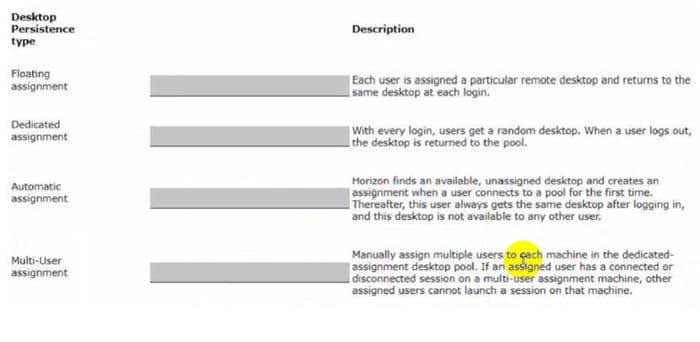
Correct Answer:
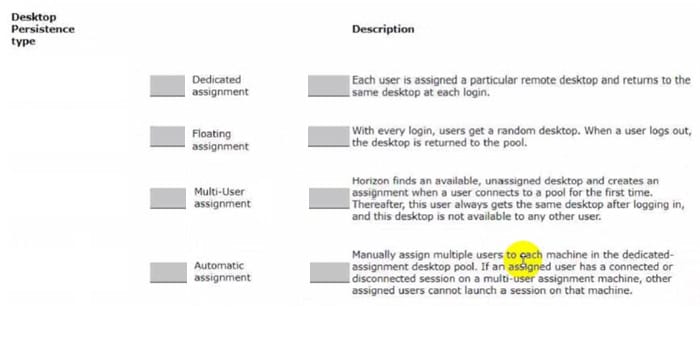
Question 10:
Refer to the exhibit.
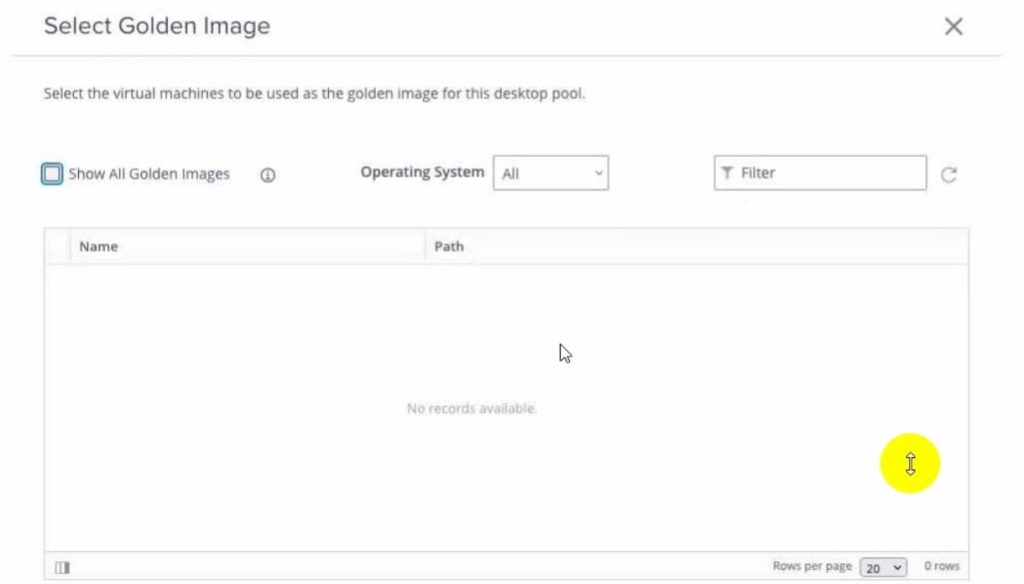
An administrator is tasked with creating an instant clone pool for their sales department. During the creation of the pool, the administrator saw that there is no golden image available, as seen in the exhibit.
Which two actions can an administrator take so that the golden image is showing up in the Golden Image selection window? (Choose two.)
A. log in to the vSphere Client, select the Golden Image virtual machine, and delete all snapshots.
B. Login to the vSphere Client, select the Golden Image virtual machine, and create a snapshot
C. Refresh the Select Golden Image view and select the Golden Image.
D. Login to the vSphere Client, select the Golden Image virtual machine, and clone it to a new virtual machine.
E. Login to the vSphere Client, select the Golden Image virtual machine, and convert it to a template.
Correct Answer: BE
Explanation:
The administrator can take two actions to make the golden image show up in the Golden Image selection window.
First, they can log in to the vSphere Client, select the Golden Image virtual machine, and create a snapshot. This will make the golden image available in the selection window.
Second, they can log in to the vSphere Client, select the Golden Image virtual machine, and convert it to a template. This will also make the golden image available in the selection window. A golden image is a virtual machine that contains the operating system, applications, and settings that are required for an instant clone desktop pool.
To create an instant clone desktop pool, the administrator must select a golden image and a snapshot from the vSphere inventory. The snapshot must be taken after installing and configuring the Horizon Agent on the golden image1. If there is no snapshot or no template available, the golden image will not show up in the selection window.
The other options are not correct for this scenario: Login to the vSphere Client, select the Golden Image virtual machine, and delete all snapshots. This option is not correct because deleting all snapshots will not make the golden image show up in the selection window.
In fact, it will prevent the administrator from creating an instant clone desktop pool, as a snapshot is required for instant cloning2. Refresh the Select Golden Image view and select the Golden Image. This option is not correct because refreshing the view will not change the availability of the golden image in the selection window.
The administrator must create a snapshot or a template of the golden image before it can be selected. Log in to the vSphere Client, select the Golden Image virtual machine, and clone it to a new virtual machine.
This option is not correct because cloning the golden image to a new virtual machine will not make it show up in the selection window. The administrator must still create a snapshot or a template of the cloned virtual machine before it can be selected.
References: Preparing a Golden Image Virtual Machine for Instant-Clones Snapshot vmdk files of the golden image used to publish Instant clone … Create an Automated Instant-Clone Desktop Pool Instant Clone Desktop Pools [VMware Horizon 8. x Professional]
Question 11:
Which two of the following are features of VMware Horizon Agent for Linux? (Choose two.)
A. USB redirection
B. Location-based printing
C. display protocol PCoIP
D. installation registration requirement
E. session collaboration
Correct Answer: AC
Explanation:
VMware Horizon Agent for Linux is a software component that enables Linux machines to be used as remote desktops or published applications in a Horizon environment.
Horizon Agent for Linux supports several features that enhance the user experience and manageability of Linux desktops and applications, such as USB redirection, display protocol PCoIP, multiple-session mode, single sign-on, smart card authentication, and 3D graphics34.
However, Horizon Agent for Linux does not support location-based printing or session collaboration features that are available for Windows machines5. Also, Horizon Agent for Linux does not require installation registration as it automatically registers with the Connection Server when the view agent service is started6.
References:= 3: VMware Horizon 8 Documentation: Horizon Agent for Linux 4: VMware Horizon 8 Documentation: Features Supported by Horizon Agent for Linux 5: VMware Horizon 8 Documentation: Features Not Supported by Horizon Agent for Linux 6: VMware Horizon 8 Documentation: Install Horizon Agent on a Linux Machine
Question 12:
Which three of the following are the benefits of using Virtual Machines? (Choose three.)
A. Difficult to move or copy.
B. Independent of physical hardware.
C. Faster to provision.
D. Bound to a specific set of hardware components.
E. Easy to move or copy.
Correct Answer: BCE
Explanation:
One of the benefits of using virtual machines is that they are independent of physical hardware. This means that they can run on any compatible host machine, regardless of the underlying hardware components.
This also enables them to be migrated, moved, or copied easily from one host to another, without requiring any reconfiguration or installation. This enhances the flexibility and portability of virtual machines, as well as their availability and disaster recovery.
Another benefit of using virtual machines is that they are faster to provision than physical machines. This is because they can be created from templates or snapshots, which contain preconfigured operating systems and applications.
This reduces the time and effort needed to install and configure software on each machine. Moreover, virtual machines can be cloned or duplicated quickly, allowing for rapid scaling and deployment of multiple identical instances.
References:= Virtual Machines Overview Creating and Provisioning Virtual Machines Migrating Virtual Machines
Question 13:
Refer to the exhibit.
Drag and drop the ports on the left to allow an external Blast Extreme connection through the Unified Access Gateway (UAG) into the diagram on the right.
Select and Place:
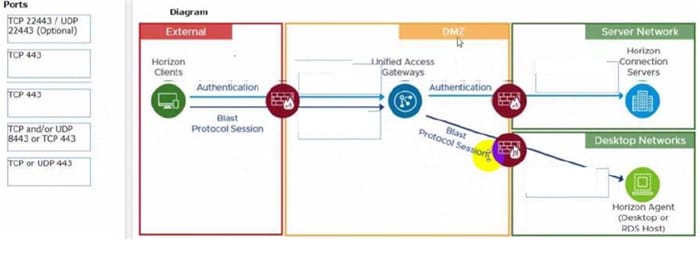
Correct Answer:
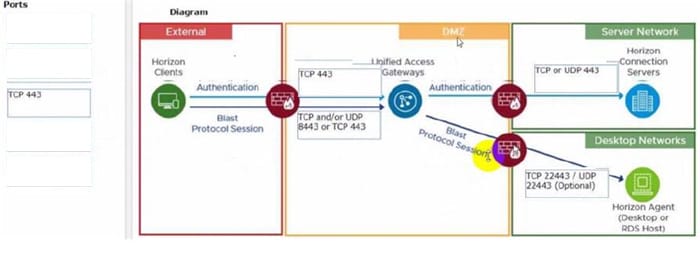
C:\Users\Waqas Shahid\Desktop\Mudassir\Untitled.jpg
Question 14:
An administrator has added a supported PCI graphics accelerator to a virtual machine configuration. When the administrator tries to power on the virtual machine, an error is displayed and the virtual machine remains powered off.
Which of the following virtual machine configuration settings needs to be applied to enable the virtual machine to power on?
A. Enable Video Card 3D Graphics.
B. Reserve all guest memories.
C. Set Memory Shares to High.
D. Disable CPU Hot Plug.
Correct Answer: B
Explanation:
To enable a virtual machine to power on with a PCI graphics accelerator, such as a GPU, attached to it, the administrator needs to reserve all guest memory for that virtual machine. This is because PCI devices require direct memory access (DMA) to function properly, and memory overcommitment can interfere with DMA operations.
Reserving all guest memory ensures that no memory swapping or ballooning occurs on the virtual machine and that the memory address space is contiguous and available for DMA56.
The other options are not required or valid because Enabling Video Card 3D Graphics is not necessary for using a PCI graphics accelerator.
This option is for using software-accelerated graphics or virtual shared graphics acceleration (vSGA) on a virtual machine7. Setting Memory Shares to High does not guarantee that all guest memory will be reserved. Memory shares only affect how memory resources are distributed among competing virtual machines when there is memory contention on the host.
Memory shares do not prevent memory overcommitment or swapping. Disabling CPU Hot Plug does not affect the use of a PCI graphics accelerator. CPU Hot Plug allows adding or removing virtual CPUs from a powered-on virtual machine. It has no relation to PCI devices or DMA operations.
References:= 5: VMware vSphere 7 Documentation: Add a PCI Device to a Virtual Machine 6: VMware Knowledge Base: Enabling DirectPath I/O causes virtual machines to fail to power on (1010789) 7: VMware Workstation Pro Documentation: Prepare a Virtual Machine to Use Accelerated 3D Graphics: VMware vSphere Resource Management Documentation: Memory Resource Management: VMware vSphere Virtual Machine Administration Documentation: Hot Add Memory and CPU Resources
Question 15:
An administrator is creating an instant clone desktop pool and needs to enable NVIDIA Grid 3D Rendering. NVIDIA GRID vGPU and drivers are installed on the physical ESXi hosts.
In Horizon Console, when creating an instant-clone pool, the NVIDIA GRID vGPU option is not available in the 3D Render field.
Which two of the following could be the reason for the issue? (Choose two.)
A. Horizon 8 does not have an explicit 3D renderer option for instant clone. Select Manage Using vSphere Client in the 3D Render field. Instant clones inherit the settings configured in the vSphere Client for the golden image.
B. In Horizon Console, when an instant-clone pool is created, the golden image and snapshot that the administrator selected have not been configured for NVIDIA GRID vGPU.
C. The administrator has selected Shared when editing the Host Graphics Settings for the ESXi host in the vCenter Server.
D. Instant-clone pools do not support NVIDIA GRID vGPU.
E. The administrator has selected Shared Direct when editing the Host Graphics Settings for the ESXi host in the vCenter Server.
Correct Answer: AB
Explanation:
To enable an instant-clone pool to use NVIDIA GRID vGPU, the administrator needs to do the following:
Install NVIDIA GRID vGPU in the physical ESXi hosts and select Shared Direct in the Host Graphics Settings12.
Prepare a golden image with NVIDIA GRID vGPU configured, including selecting the vGPU profile to use12.
Take a snapshot of the golden image12.
In Horizon Console, when creating an instant-clone pool, select Manage Using vSphere Client in the 3D Render field. Instant clones inherit the settings configured in the vSphere Client for the golden image12.
Therefore, the possible reasons for the issue are:
The administrator has selected Shared instead of Shared Direct when editing the Host Graphics Settings for the ESXi host in the vCenter Server. This option is for vSGA, not vGPU3.
The golden image and snapshot that the administrator selected have not been configured for NVIDIA GRID vGPU. The administrator needs to verify that the correct vGPU profile is selected and that the NVIDIA drivers are installed in the golden image4.
The other options are not valid because:
Horizon 8 does have an explicit 3D renderer option for the instant clone, but it is Manage Using vSphere Client, not NVIDIA GRID vGPU12. Instant-clone pools do support NVIDIA GRID vGPU as long as the ESXi hosts and the golden image are properly configured12.
References:= 1: VMware Horizon 8 Documentation: Enable NVIDIA GRID vGPU for Instant-Clone Pools 2: VMware Horizon 8 Documentation: Configuring 3D Rendering for Automated Instant Clone Farms 3: VMware Horizon 8
Documentation: Types of Graphics Acceleration 4: VMware Horizon 8 Documentation: Prepare a Virtual Machine to Use Accelerated 3D Graphics
…
Finally:
Download the complete VMware 2V0-51.23 actual questions and answers: https://www.leads4pass.com/2v0-51-23.html, with two practice tools, PDF and VCE. Complete all practice tests to ensure 100% success.